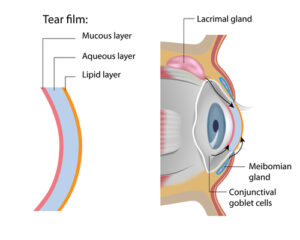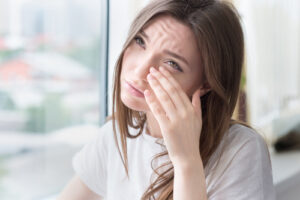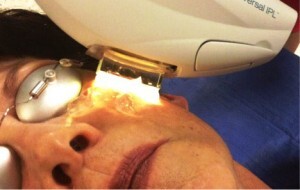Millions of Americans have been diagnosed with dry eye syndrome, but many more are unaware their symptoms result from dry eye syndrome. This highly prevalent condition involves much more than having dry eyes.
Patients can experience a range of symptoms that they may not realize are related to dry eye. By understanding the typical effects of this eye condition, it becomes possible to treat its root cause so that you can find much-needed relief.
The Dell Eye Institute for Dry Eye Research at Dell Laser Consultants is the only comprehensive dry eye clinic in Central Texas dedicated to treating patients with dry eyes. Keep reading to learn more about dry eye syndrome and the symptoms you may experience!
What Is Dry Eye Syndrome?

Dry eye syndrome is a chronic condition that occurs if you have a tear imbalance. It is one of the most common eye conditions.
Your eyes get their moisture from tears. A tear has three layers: a water layer, an oily layer, and a mucus layer.
Each of these has a specific purpose. The water layer provides the moisture, while the oily layer keeps the eye lubricated. It helps prevent tears from evaporating too fast as well.
The mucus layer facilitates the spreading of the water over the eye. Tears are an essential component of how your eyes stay healthy.
Every time you blink, it distributes the tear film across the eye’s surface. Distributing the tear film allows you to see clearly, by providing a smooth surface to refract light properly. They also ensure that your eyes are comfortable.
What Causes Dry Eye Syndrome?

Dry eye syndrome develops when there is instability in any part of the tear production process. The eye may not produce enough tears, or the tears produced may not be of a high enough quality.
Various factors can lead to the development of having dry eyes. It can occur at any age, but your risk increases as you get older, especially in women after menopause.
Certain diseases, such as rheumatoid arthritis, thyroid disease, and Sjögren’s syndrome, can negatively affect your body’s ability to produce tears. In addition, some medications (particularly antihistamines and beta-blockers, among others) can cause dry eye as a side effect.
Lifestyle choices are another factor in your likelihood of developing ocular dryness. Contact lenses can block oxygen from entering the eye, so you may experience a lack of moisture after wearing them for an extended time.
Staring at a computer screen or another type of screen for too long can negatively affect eye moisture because it reduces your blink rate. Your environment can also dry your eyes out, whether inside or outside.
Windy or arid air can make it difficult for the eye to retain moisture. Irritants like smoke, dust, and bacteria can wind up in your eyes and compromise the tear film’s ability to keep them lubricated.
The Most Common Symptoms of Dry Eye

Beyond dryness, the most common symptoms of dry eye include:
- Itching
- A burning or stinging sensation
- Grittiness
- Redness
- Light sensitivity
- Decreased night vision
- Blurry vision
- Discomfort when wearing contacts
- Excess watering
You may be surprised to learn that watery eyes are a symptom of dryness. Your eyes will water more because they attempt to compensate for the lack of moisture by over-producing tears.
How Is Dry Eye Syndrome Treated?
If you are experiencing any of the above symptoms, you don’t have to suffer. Fortunately, there are a variety of treatments available to ease your symptoms.
At Dell Laser Consultants, we will conduct a thorough examination and discuss your unique needs to tailor your treatment. The best place to start for many patients is with artificial tears, gels, and ointments to add moisture back into the eyes.
These work by improving the quality of tears, easing your symptoms, facilitating tears spreading over the eye, and lubricating it. Your eye doctor may prescribe an eye drop such as Xiidra, Cequa, and RESTASIS® to help the eyes produce more tears while reducing inflammation.
If you’re having difficulty keeping tears in your eyes, you may have punctal plugs placed in your eyes. These tiny, minimally invasive devices stop tears from draining. They can be temporary or permanent.
Intense Pulsed Light Therapy (IPL) and TearCare are two treatments that can also help patients find relief.
TearCare
TearCare is a system that uses heat and expression on blocked meibomian glands to help treat meibomian gland dysfunction (MGD). TearCare evacuates obstructed meibomian glands to treat MGD while also using an open-eye design to facilitate natural blinking.
Using TearCare can help address evaporative dry eye and keep tears in the eyes for longer. Treating meibomian gland dysfunction can help many patients find relief from their dry eye symptoms.
Intense Pulsed Light Therapy

IPL therapy is often used as an off-label treatment for patients with dry eyes or ocular rosacea. Although intense pulsed light therapy is typically used to treat facial conditions like rosacea, it can also be an effective way to treat chronic dry eye and MGD.
IPL works by delivering pulses of light to liquify and release blocked meibomian glands, which harden over time. The light pulses heat skin located around the eye to dislodge any oil buildup in the meibomian glands.
By expressing these glands, patients can start to see improved dry eye symptoms. It can take several IPL treatments to start seeing results.
Patients may need to see their eye doctor at Dell Laser Consultants for monthly treatments over the course of four months for the best results, or further treatments depending on how severe their dry eye symptoms are.
Easing Your Dry Eye Symptoms at Home

You can try a few different methods at home to soothe your dry, irritated eyes. Many patients can find quick relief by placing a warm compress over their eyes.
Make sure you keep the area around your eyes clean to prevent inflammation. Your diet and water intake can help improve how dry your eyes feel.
It’s necessary to keep your body hydrated. Aim to drink at least eight glasses of water a day.
Eat plenty of foods rich in oils and omega-3 fatty acids, like salmon, tuna, walnuts, and flaxseed. If the environment around you, or a lifestyle choice, is causing your dry eyes, it is worth it to make modifications when possible.
If the air in your home is dry, use a humidifier to add moisture back into the air and keep your eyes more lubricated. Try not to look at a screen for an extended time.
If you have to, take frequent breaks and follow the 20-20-20 rule. With this rule, look at an object at least 20 feet away for 20 seconds every 20 minutes. During this time, you can practice slow blinking and use eye drops to prevent feelings of dryness.
Are dry eyes making it challenging to take part in everyday activities? You don’t have to suffer! Schedule an appointment at Dell Laser Consultants in Austin, TX, to get the relief you need!





